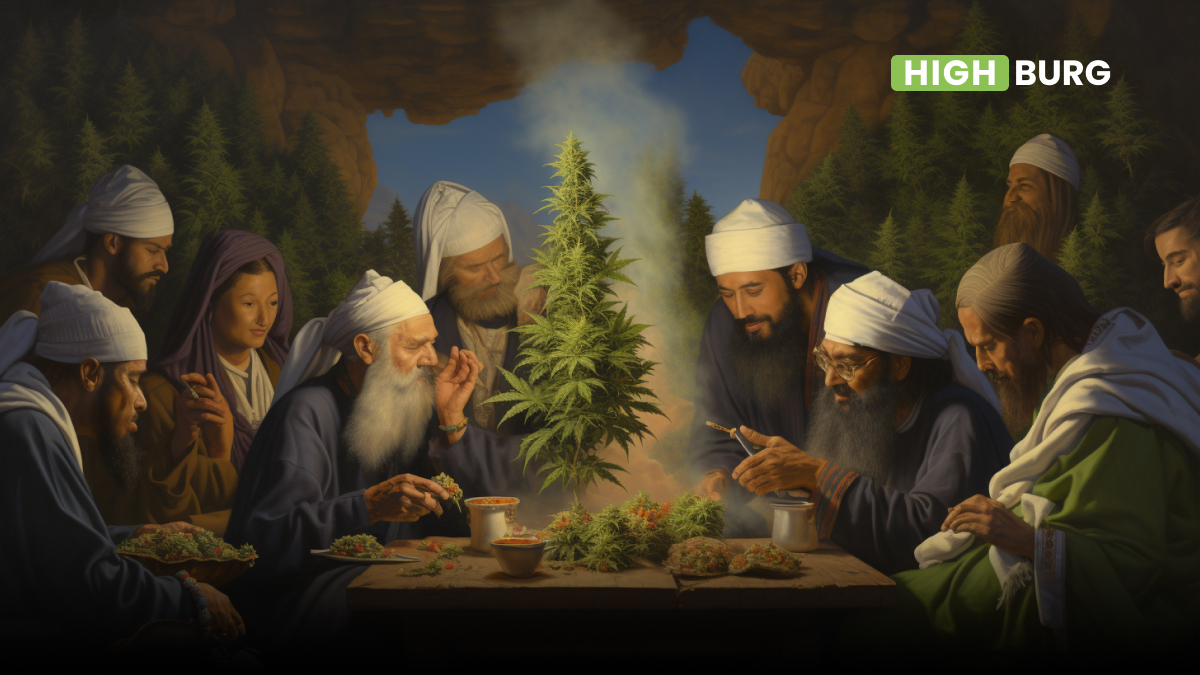Thousands of years ago, our ancestors were continuously discovering the world; explorers, philosophers, and scientists contemplated nature to understand its mysteries. Back then, the tools to understand the world were insufficient, and mere observation could not give all the answers needed to comprehend the mysteries of nature. Where understanding could not reach, mysticism did. Thus the first religions were born, with the intention of giving explanations and justifications to events that seemed inexplicable in their complexity and perfection.
Nature and religion are closely connected; Just think that the first god men used to revere was the sun. It is likely that cannabis was first used as a ceremonial incense in early religious rituals along with other relaxing herbs. By inhaling the fumes full of cannabinoids, the shamans ensured a mystical experience capable of bringing them closer to the gods they worshipped. Thanks to these properties, shamans considered cannabis a sacred herb capable of putting them in contact with the divine. It goes without saying that cannabis appears in depictions and sacred texts from all over the world, from ancient Egypt to Shinto Japan.
Taoism
Taoism was born in China in the 4th century BC. Historians attribute the authorship of this religion to the philosopher and writer Lao Tzu, although its existence has not yet been confirmed. In Taoist philosophy, the universe is a single tangle of conscious energy. The “Tao” is the source of this energy, which flows and enlivens all things. Taoists firmly follow three principles called the Three Treasures, which are compassion, sobriety, and humility. They also participate in exercises, rituals, and spiritual journeys in a state of ecstasy to take energy from the cosmos and prolong their lives. Taoists seemed to greatly appreciate the properties of cannabis, with some sects even portraying it as a personified deity. From their texts, it is clear how much cannabis was an integral part of the rituals. The Taoist encyclopedia Wushang Biyao, written in AD 570, records the use of cannabis in incense burners and how practitioners purposely inhaled the fumes to alter their state.
Buddhism
Buddhism was born between the 6th and 4th centuries BC in India, and its philosophy revolves around five principles: Karma, rebirth, liberation from the rebirth cycle, and liberation from pain. They also follow a set of rules called the Five Precepts, and the fifth precept prohibits polluting the body with substances such as alcohol and drugs. However, in the Mahakala Tantra, prescriptions for cannabis and other psychoactive substances are found for therapeutic purposes. It is even said that the Buddha, on his path to enlightenment, undertook a diet that consisted of one hemp seed a day for six years (even if the seed does not actually contain an active ingredient, therefore it cannot be considered a drug). In summary, Buddhists have a divided view on cannabis; some sects are firmly against its use, while others are more open.
In Theravada Buddhism, for example, the five precepts are followed to the letter, as this is the most ancient form of Buddhism. As a result, they strongly oppose the use of cannabis in any form.
Mahayana Buddhism, on the other hand, while accepting the first Buddhist teachings, independently brought new sacred scriptures. According to their ethical code, everything that can benefit man must be accepted, including cannabis for therapeutic purposes.
Vajrayana Buddhism focuses on karma as the most important concept. This doctrine is more lenient on cannabis use and taboos in general, urging men to find purity in everything.
Hindu
In the Hindu sacred text called the Atharvaveda, cannabis is revered as one of the five sacred plants. The belief says that in every cannabis leaf, there is a guardian angel. The Vedas tell how cannabis was administered to people for pleasure and to eliminate fears; the plant was considered a source of happiness. Shiva himself created the plant by extracting it from his body, calling it Angaja (out of the body), and it is believed that the name ganja comes from this. In Hindu practices, cannabis is administered in three ways: bhang, a cannabis-based drink with honey and spices; smoking charas, hashish made from resin; or smoking the buds. Consuming cannabis in any form during religious festivals is considered a sacred act in the Hindu religion.
Shinto Japan
The relationship between cannabis and Japan dates back thousands of years; just think that the first cannabis seed was found in Japan ten thousand years ago. Shinto also has a history as old as the nation itself. This religion has a different nature from the others: it arose organically from all members of society, and there is no real pantheon. The songs and rituals are very particular and different from each other precisely because they were born from ordinary people and not from priests. Men coexisted with spirits called “kami” who manifested themselves in the form of natural phenomena. In this religionthere were no rules or dogmas to follow, men were considered fundamentally good in their imperfections; however, it could happen that they were possessed by evil spirits. The only thing to worry about in this religion is evil spirits, and what’s the best way to cast out demons? Cannabis, of course. In Shinto, cannabis has an important spiritual meaning: priests burned and waved branches of cannabis above it to drive away evil spirits and help possessed people.
Ancient Greek religion
Cannabis was used in religious rites even in ancient Greece, as evidenced by the historian Herodotus (484–425 BC). He describes how the Scythians burned cannabis as incense in small containers or over open flames. During the rituals, the participants gathered in small tents, burned the cannabis inside, and inhaled the fumes. It is also believed that the Assyrians burned cannabis during funeral rites to drive away evil spirits.
Paganism
According to Norse mythology, cannabis had in itself the power of the goddess Freyja, goddess of love, beauty, and fertility, and its intake would give the strength of the goddess to the consumer. Cannabis was part of pagan religious life and was used during rituals to promote fertility. It was considered a very important plant, and even the harvest was an occasion for celebration. It was so important that hemp clothes and cannabis seeds were given to the dead in funeral rites.
Judaism
Genesis 1:29. Then God said: “I give you every seed-bearing plant on the face of the whole earth and every tree that has fruit with seed in it. They will be yours for food.” Little is known about the connection between the Jewish religion and cannabis; it is a hot topic of discussion. Maimonides, a medieval Torah scholar, was a proponent of cannabis oil as a remedy for respiratory ailments. Rabbis are divided on cannabis, with some saying it’s a dangerous substance to keep away from, while others say it’s kosher (approved for consumption). Judaism is a more “concrete” and less spiritual religion; the concept of prayer is focused on contemplation and discipline. According to some, cannabis could bring that little bit of spirituality that helps with contemplation and reflection. As in other situations where it is not possible to distinguish between right and wrong, the Jewish community will continue to debate cannabis for a long time without reaching a definitive conclusion. Some steps have been taken towards using cannabis for medical purposes, but nothing is moving towards recreational use.
Christianity
In Christianity, there is a divided opinion on the use of cannabis. Some orientations, such as the Orthodox, Protestants, and Catholics, prohibit the consumption of the plant. However, other doctrines, such as those of the Presbyterian Church, the United Church of Christ, and the Episcopal Church, approve the use of cannabis, but only for therapeutic purposes. As mentioned before, the use of the plant also seems to be authorized in the Bible (“I give you every seed-bearing plant on the face of the whole earth and every tree that has fruit with seed in it. They will be yours for food”) but this passage seems to conflict with Peter 5:8. “Be alert and of sober mind. Your enemy, the devil, prowls around like a roaring lion looking for someone to devour.” Some scriptural scholars, based on references to the herb Kaneh Bosem, argue that Jesus and his disciples used cannabis oil for sacred anointing.
Rastafarianism
Rastafarianism is the youngest of the religions covered in this article, but it is also the one that has incorporated the use of cannabis into its rituals the most. Born in the 1930s, Rastafarianism, which rejects oppression and materialism, considers cannabis a sacred herb capable of purifying the spirit and bringing you closer to Jah (abbreviation of Jehova, the name of God). This religion has many aspects in common with Judaism and Christianity; their reference book is, in fact, the Bible. Almost everyone follows the directions of Leviticus, avoiding eating shellfish and pork, while others follow a vegetarian diet. Cannabis is used during “grounding” rituals, where worshipers gather to smoke cannabis, play drums, and sing hymns to bond with each other and with Jah. Cannabis is considered a sacrament capable of giving love, favoring introspection, and bringing you closer to divine enlightenment.



